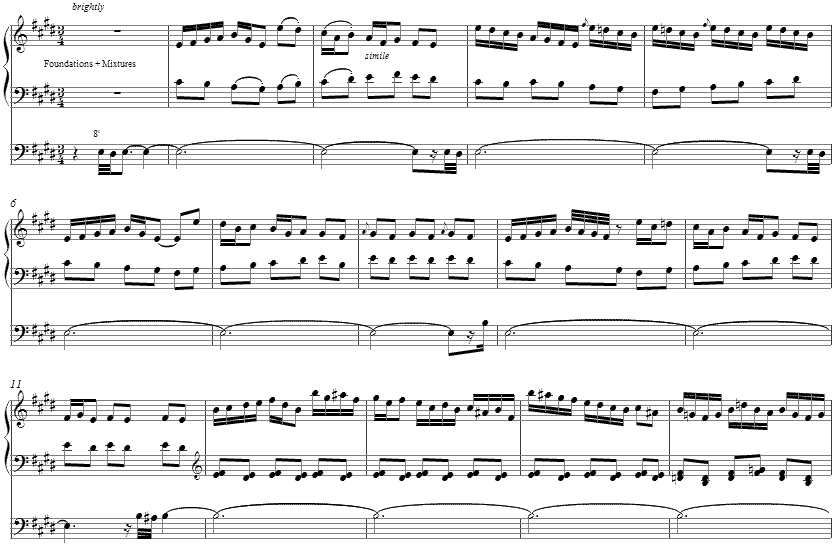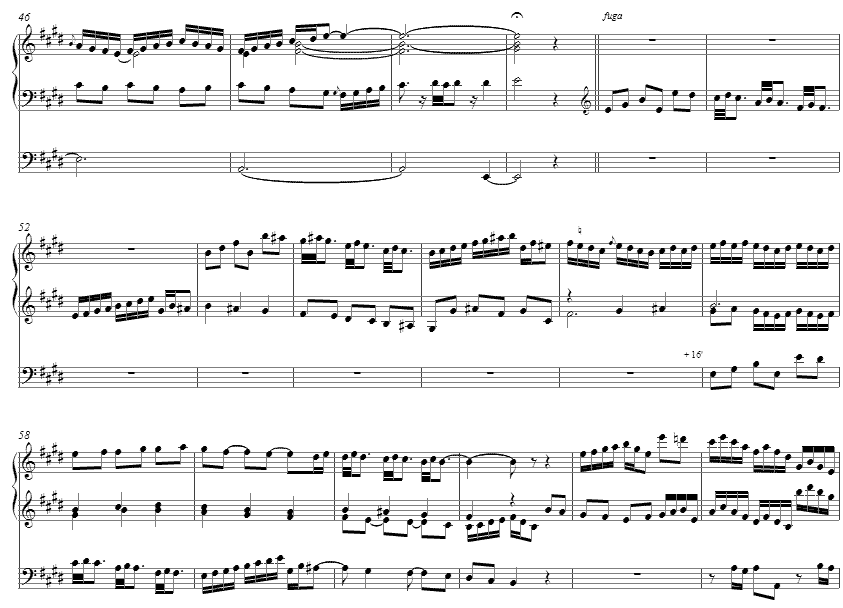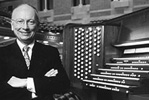Music and Texts of GARY BACHLUND
Vocal Music | Piano | Organ | Chamber Music | Orchestral | Articles and Commentary | Poems and Stories | Miscellany | FAQs
Prelude and Fugue in E major - (1995)
for organ
for Dr. Thomas Harmon
Among the themes of this work are the opening triadic scale, from which the fugue subject is adapted, and an unusual choice. For the counterpoint, an emphasis on seconds was chosen, such that in the last beat of measure three, F sharp against E and E against D sharp, function as do the parallel thirds also found in the texture. The seconds become more insistent by measure 12, and the counterpoint for the fugue subject functions in a similar manner. Nonetheless, the thematic development is tuneful, and the short diversion to G in the progress of the fugue is generated by the implications of these seconds.
The fugue subject is simply the prelude's, absent the scalar passing tones. At measure 54, the dissonance of the seconds is seen, now displaced by an octave. After the normal tonic and dominant domains are visited through following the fugue subject, the additional region of G imposes itself for a moment and another fugue entrance in the pedal.
[ 8 pages, circa 4' 20" ]
Professor Thomas Harmon at Royce Hall, UCLA
Dr. Thomas Harmon served for many years as professor of organ and University Organist at the University of California, Los Angeles, where over many years I studied music education and aesthetics, and of course composition and theory with a fine faculty, earning both my masters degree and PhD in music in the composition department. I remain amused that the university music department's occasional publicity has pointed to my career as an opera and concert singer, though I studied neither voice nor opera there.
A fine performer, Tom Harmon served on my doctoral committee, advising me on the large organ work, The Jerusalem Windows.
An anecdote from my many meetings with Tom. As more of my score for what became the seven movement of "The Jerusalem Windows" was being written, I would bring him sketches, completed portions of movements as well my technical questions about voicings, registrations and virtuosic demands which might be placed upon the performer. More often than not, Tom and I would see "eye to eye." A very stimulating member of my doctoral committee, he once could not come to understand a polytonal harmonic progression I had sketched as "functional," though I argued it was. The discussion revolved around seconds and their harmonic and voice leading implications, and I won the day as he became convinced of this small musical and aesthetic issue between us in a sketch towards the larger work. Therefore, to pleasantly commemorate that sometimes spicy discussion, I chose to set out another such pre-compositional hurdle and build in seconds which would function tunefully within the constraints and understandings of the common practice tradition.
Tom's challenge was simple. All too many modern composers had become encouraged by their master teachers to write dissonant "anythings," to use Tom's phrase. Meaning was not at issue, and often the pieces lacked some logical storytelling sense in which one could follow the story of a theme and its development. The real question is to use dissonances in ways which allow the semiotic functions of those themes and textures, aesthetic stances and ideas, to communicate a musical moment in which sense and logical communication might be experienced. Ergo, this little prelude and fugue adds a small additional understanding of functional linear writing within a contrapuntal texture, wherein parallel seconds play a tuneful part of their own all the while linked to our musical past. My thanks to Tom is herewith "noted."
For the entire MP3 file, click here:
The score is available as a free PDF download, though any major commercial performance or recording of the work is prohibited without prior arrangement with the composer. Click on the graphic below for this organ score.


